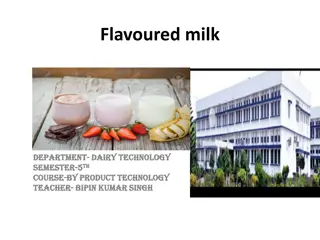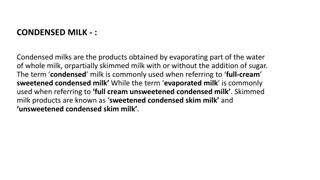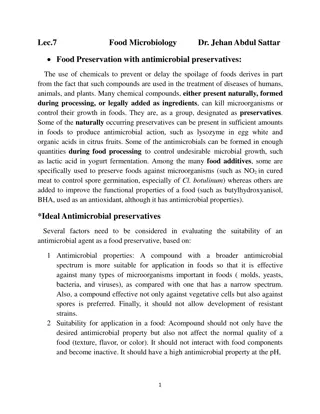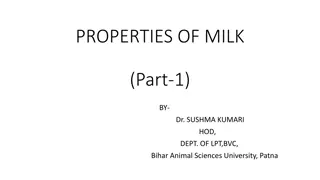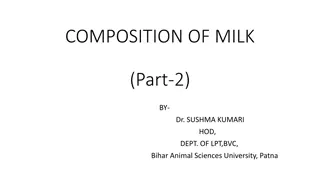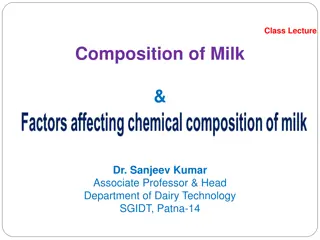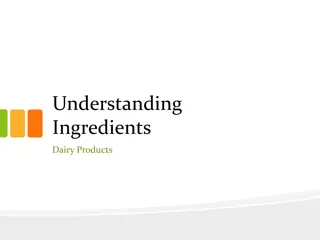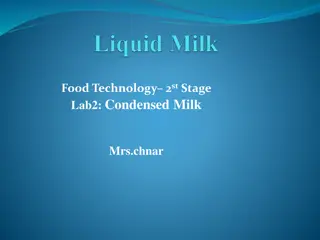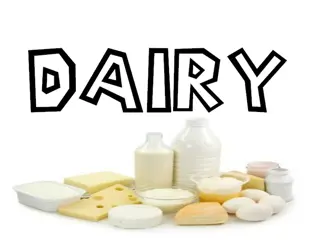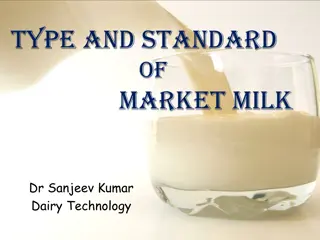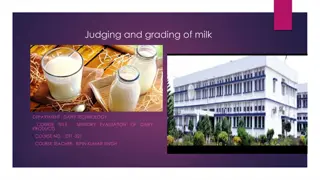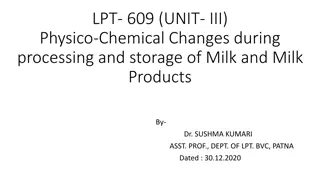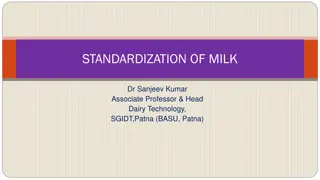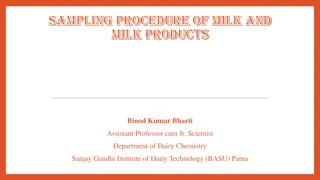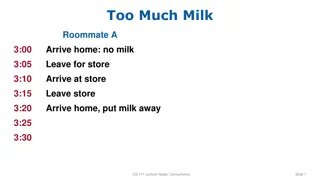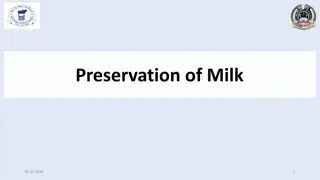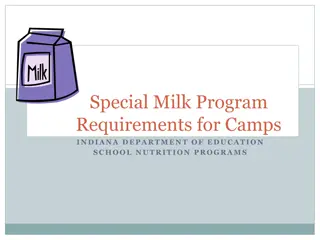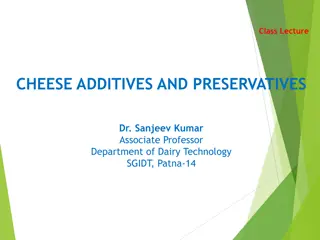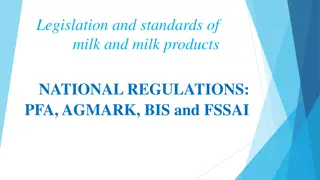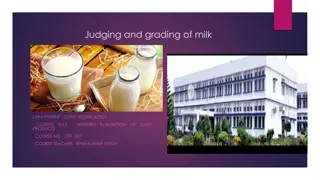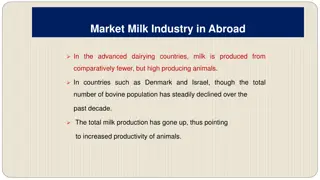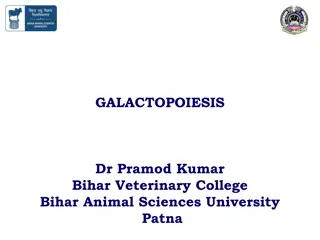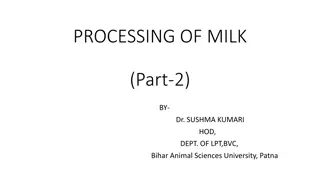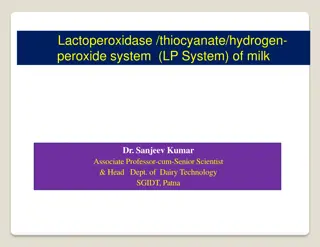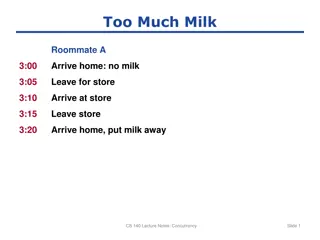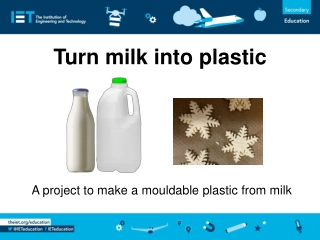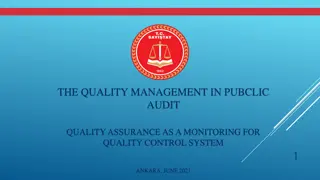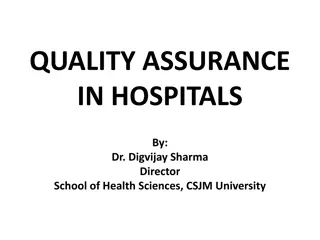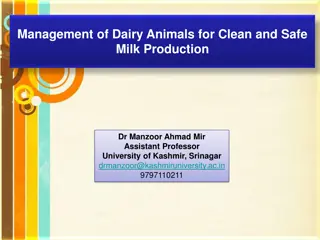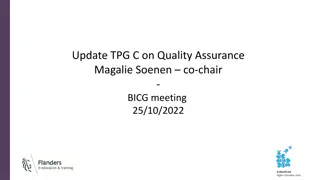Milk Quality Assurance: Detection of Neutralizers, Adulterants, and Preservatives
This study focuses on techniques for estimating neutralizers, adulterants, and preservatives in milk and milk products, including tests for Rosalic Acid, alkalinity of ash, sugar, starch, and glucose. Each test involves specific procedures using apparatus and reagents to detect the presence of certain substances, ensuring the quality and authenticity of milk products.
Download Presentation

Please find below an Image/Link to download the presentation.
The content on the website is provided AS IS for your information and personal use only. It may not be sold, licensed, or shared on other websites without obtaining consent from the author. Download presentation by click this link. If you encounter any issues during the download, it is possible that the publisher has removed the file from their server.
E N D
Presentation Transcript
Estimation of neutralizers, adulterants and preservatives in milk and milk products DTC 311 (Chemical quality Assurance) Binod Kumar Bharti Assistant Professor cum Jr. Scientist Department of Dairy Chemistry S.G.I.D.T., (BASU) Patna
Detection of Neutralizer RosalicAcid Test Principle Rosalic acid develops a rose red colour with milk containing carbonate and bicarbonate. Apparatus Test Tube, Pipette Reagents 1. RosalicAcid one percent (w/v) in ethyl alcohol 2. 2. Ethyl alcohol-95percent by volume Procedure 1. Take 5 ml milk in a test tube of capacity 20 ml. 2. Add 5 ml ethanol (95%,v/v) and 3. 4 drops of Rosalic acid solution (0.05%; w/v in ethanol). Mix the contents. Observe the colour. Interpretation If carbonate or bicarbonate is present a rose red color will appear. If NaOH is present a pink colour will appear.
Alkalinity of ash test Apparatus- Muffle Furnace, Silica crucible Chemicals- N/10 HCl, Phenolphthalein Principle- 1. Take 20 ml milk in a silica crucible. 2. First evaporate the water to dryness, and then burn the content to ash in a muffle furnace at 550 C. 3. Disperse the ash in 10 ml distilled water and titrate the ash content against N/10 HCl using phenolphthalein as indicator. Interpretation- If the volume of N/10 HCl exceeds 1.20 ml, then the milk contains the added neutralizers.
Determination of Sugar Materials required Boiling water bath, Test tube Chemicals required Resorcinol solution, Hydrochloric acid Methods 1.Take 1ml of milk sample 2. Add 1 ml of 0.5% resorcinol solution (0.5% resorcinol solution in 3N Hydrochloric acid). 3. Mix the contents and heat in boiling water bath for 5 min and observe the colour Observation If sugar is present in the sample, the red color will be produced. Blank shows pale yellow or brownish color.
Determination of Starch Determination of Starch Materials required Test tube Chemicals required 1% iodine solution Methods 1. Take 3.0 ml of suspected milk sample in a test tube. 2. Add one drop of 1% iodine solution (1gm of iodine crystals and 5gm Potassium iodide in 100 ml distilled water, mixed by warming to dissolve the iodine crystals). 3. Mixing the contents and observe the colour Interpretation: Development of blue color indicates the presence of starch.
Determination of Glucose Reagents a) Barfoed s reagent ( Prepared by dissolving 24 gm of cupric acetate in 450 ml boiling distilled water and immediately adding 25 ml of 8.5% lactic acid to the hot solution and cooling and diluting the contents to 500 ml). b) Phosphomolybdic acid reagent. (Dissolve 35gm of Ammonium molybdate and 5 gm of sodium tungstate in 400ml of 5% (W/V) Sodium hydroxide solution. Boil the contents vigorously for 20 40 min so that the reactants are dissolved properly. While boiling, the ammonia is released. No change in the color of litmus paper indicates that reagent is free from ammonia. As a result of boiling, water gets evaporated, now cool the contents and dilute to about 350 ml and add 125ml of concentrated (85%) phosphoric acid. Finally make the volume to 500ml with distilled water).
Apparatus Test tube, boiling water bath Methods 1. Take 1ml of adulterated milk sample in a test tube 2. Add 1 ml of Barfoed s reagent. 3. Heat the mixture for 3 min in a boiling water bath and cool for 3min under tap water. 4. Add 1ml of phosphomolybdic acid reagent and 5. Mix the contents and observe the colour. Interpretation: Formation of blue color indicates the presence of glucose.
Determination of Dextrin/ Maltodextrin Reagents Iodine solution, % Potassium iodide solution Apparatus Test tube, Methods 1. Take 1ml of suspected milk sample in a test tube. 2. Add 1 ml of iodine solution (0.005N Iodine solution prepared using 3% Potassium iodide solution in water). 3. Mix the contents and observe the colour. Interpretation: Development of chocolate red brown color indicates the presence of dextrin/ maltodextrin.
Determination of Formaldehyde Hehner Test: Reagents Sulfuric acid, Ferric chloride Apparatus Test tube, Methods 1. Take 10 ml of the suspected milk sample in a test tube. 2. Add 0.5 ml of ferric chloride solution. 3. Add gently 5 ml of sulfuric acid along the side of the tube so that it forms a layers at the bottom without mixing the milk. Observe the colour. Interpretation Formation of a violet to purple colored ring at the junction of the two liquids indicates the presence of formalin in the milk sample.
Determination of Formaldehyde Leech test: Reagents concentrated HCl, ferric chloride solution Apparatus Test tube, Bunsen burners Methods:- 1. Take about 5.0 ml of milk in a test tube. 2. Add to it equal volumes of concentrated HCl containing 1.0 ml of 10% ferric chloride solution to each 500 ml of the acid. 3. Heat over a flame for about five minutes. Rotate the tube to breakup the curd, and observe the color. Interpretation Development of violet color indicates the formaldehyde added as a preservative.
Detergents in Milk Chemicals: Methylene blue solution, chloroform Methods i) Take 2.0 ml of milk in a test tube and ii) add 1.0 ml of 0.025% methylene blue solution in water. iii) Mix the contents and add 5.0 ml of chloroform and shake the contents vigorously. iv) Keep the tubes undisturbed for 15 min or centrifuge the contents for 10 min. and observe the color in lower layer. Observation Intense blue color in lower layer indicates the presence of detergent.
Detection of Vanaspati in Ghee Isolate the fat from milk by heat clarification method. Reagents concentrated HCl, furfural solution, Methods: i. Take about 5 g of the melted fat in a test tube. ii. Add 5 ml of concentrated HCl (AR grade). iii. Add 0.4 ml furfural solution (2% in alcohol) and shake the tube thoroughly for 2 min. iv. Allow the mixture to separate. v. The development of pink or red color in the acid layer indicates presence of vanaspati. vi. Confirm by adding 5 ml distilled water and shaking again. If the color in acid layer persists, vanaspati is present. If the color disappears, it is absent SP:18 (1987).
Detection of animal body fats and vegetable oils/fats by the Opacity Test in ghee i. Melt the sample of fat (5 gm) isolated by heat clarification method at 50 +1 C in a test tube and maintain for 3 min to equilibrate. ii. Then transfer the test tube at 23 + 0.2 C water bath and record the opacity time (Time taken by fat sample to acquire either O.D. at 570 nm between 0.14-0.16 or Klett reading using red filter between 58- 62 after adjusting the instrument to 100% transmittance). iii. The opacity time of pure buffalo ghee is 14-15 min, cow ghee is 18- 19 min and that of ghee from cotton tract area is 11-12 min. iv. The opacity time of buffalo ghee adulterated at 10% level with vanaspati is 10-11 min, with pig body fat is 8-9 min, with buffalo body fat is 2-3 min, with cow body fat is 3-4 min and with refined oils is 20-25 min (Singhal, 1980).
Test for Skimmed Milk Powder in Natural milk (Cow, Buffalo, Goat, Sheep) Take 50 ml of milk in a 60 ml centrifuge tube. ii. Place the tube in the centrifuge and balance it properly. iii. Centrifuge at 3000 rpm for 15 minutes. Decant the supernatant creamy layer carefully. iv. Add 0.5 ml of 4 % acetic acid for coagulation and then add 2 ml of 1 % phosphomolybdic acid in water. v. Mix the contents thoroughly and heat in a water bath at boiling temperature for 15 minutes and then cool. vi. The curd obtained from pure milk shall be greenish in color whereas the curd of sample containing skimmed milk powder shall be bluish in color. vii. The intensity of bluish color depends on the amount of the skim milk powder present in the sample. i.
Determination of Hydrogen peroxide Reagents 2% paraphenylene diamine solution Apparatus test tube, Methods i. Take 5 ml milk in a test tube and ii. Add 5 drops of 2% paraphenylene diamine solution and shake it well. iii. Change of the color of milk to blue confirms that the milk is added with hydrogen peroxide.
Determination of Common salt Principle Detection of common salt is based on the principle of argentometric titrations. In this case excess of silver nitrate is made to react with potassium chromate and resulted in the formation of reddish brown precipitates of silver chromate. Reagents: Silver nitrate solution, potassium chromate indicator Methods: i. Take 5ml of milk in a test tube. ii. Add 1 ml of silver nitrate solution (4.3 gm/100ml double distilled water). iii. Mix it and add few drops of 5% potassium chromate indicator in water and mix the contents. Observe the color change. Observation: Development of yellow color indicates the presence of excess salt and red color indicates the absence of excess sodium chloride.


